Day 18: Bacoli
Friday, November 3, 2006: Day 18: Bacoli
The sun is back but it is comparatively chilly and breezy this morning. Our first stop this morning is the Casina Reale--a hunting lodge--built for Ferdinando IV of Bourbon on one of the volcanic lakes in the area--Lake Fusaro. It was designed by Carlo Vanvitelli, the son of the famous architect Luigi Vanvitelli (actually a German who was quite active in Italy in the 18th century). It sits about 25 yards off shore connected to the land and makes for a pretty picture.
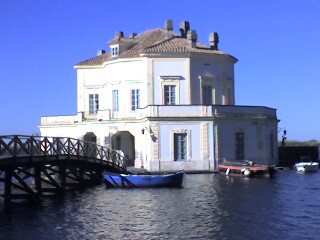
The lake is famous as the first instance of oyster farming (by the Romans) and oysters are still grown there today.
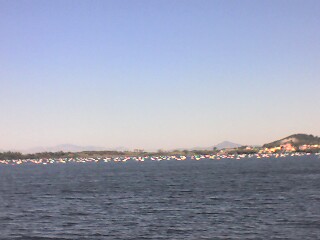
Oyster markers in Lake Fusaro
Next we visit the archaeological site of Cuma--most famous as the location of the Sibyls' cave as described in the Aeneid. H.V. Morton--travel writer par excellence--was completely enchanted with Cuma and we too found it fascinating...but in different ways.
Cuma is in an out of the way corner of the Campi Flegrei; when we get there, there are a lot of staff but we don't see any other visitors. You enter the site up a long grade and through a tunnel hewn out of the rock. There are some burial chambers on the right and the entrance to the Sybils' cave is on your left. The Sibyls of Cumae were in the same business as the oracle at Delphi (and many other prophetesses in the ancient world) and they were sought out by many for their predictive skills. The Books of the Sibyls were prized possessions of the Roman state and they were guarded tightly and consulted frequently by many Roman leaders.
Relevant passages from Virgil are inscribed in marble at the entrance to the tunnel. The tunnel leading to the cave is dug out of the rock facing of the cliff and provides a suitably mysterious entrance hall leading to the cave. The only light comes from openings cut into one side of the tunnel at regular intervals and it is still quite mysterious.
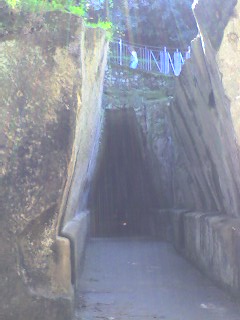
Entrance to Sibyls' Cave
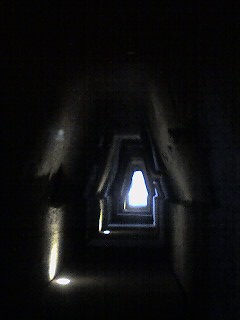
Looking back towards the entrance of the cave of the Sibyls
The petitioners would encounter the Sybils deep in the cave - there's an area where they presumably sat - she would go into a trance and answer their question. For Morton there remained a romantic, "religiously" mysterious air to the place. Not so much for us.
Once out of the cave, we climb the hill to the Acropolis of the town. Cuma was the first Greek settlement in the area -dating to 730 B.C. There are a number of temples to explore and climb around, which also have beautiful views of the surrounding countryside and the islands of Ischia and Procida. The site is very peaceful and we are more or less alone---except for the large number of staff who are reading magazines, strolling the ground and enjoying the beautiful weather. The temple of Apollo and the temple of Jupiter (at the top of the hill) are not in very good shape but on this sunny day with blue skies and no one around, we find them quite attractive and enjoy being in this ancient spot and just poking around both of the ruins.
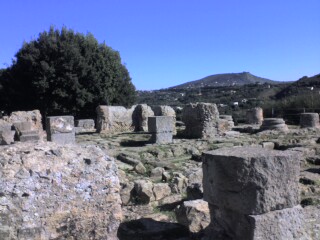
Temple of Apollo - Cuma
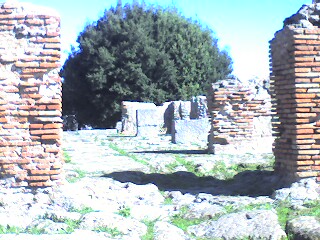
Temple of Apollo - Cuma
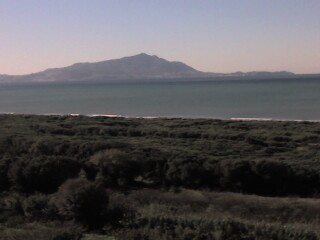
View towards Ischia from the Temple of Apollo

The Via Sacra leading to the Temple of Jupiter - Cuma
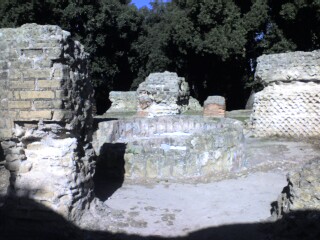
View of Temple of Jupiter - Cuma
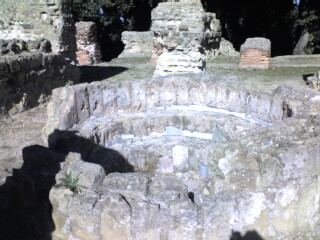
Baptismal Font (from subsequent church) - Temple of Jupiter - Cuma
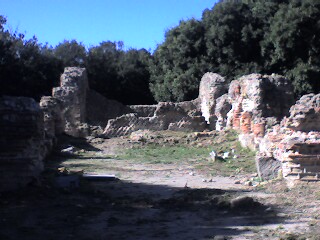
Temple of Jupiter - Cuma
We spend almost two hours at the site.....while we are admiring the view, we see movement on the beach. There are horses pulling carts moving up and down the beach...we can't tell if they are actually racing or just practicing.

If you look closely on the beach, you can make out the horse and cart.
On the road to our next stop--the Solfatara Volcano--we drive through the Arco Felice. This was a cut in the mountains that was excavated by the Romans and decorated with an elaborate arch which served as the monumental gateway to Cuma. The decorations are now gone but the arch remains intact and traffic flows through it everyday.
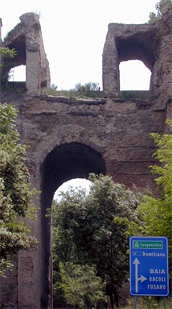
Arco Felice
Solfatara, located just above the town of Pozzuoli, is actually a "Campo Flegrea"--a burning field. It is an active volcano that looks like a moonscape punctuated with boiling mud pools and a number of holes in the ground that continuously spew hot steam. It is set in the bottom of a crater and the smell of sulfur is very strong. I had expected that much of the area would look like this but this is the only example that we come across. I am intrigued by the scene as I walk around the crater and feel the hot smelly steam.....one can imagine that this would be thought of as the entrance to the underworld.
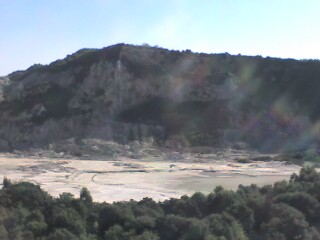
View from the top of the crater at Solfatara
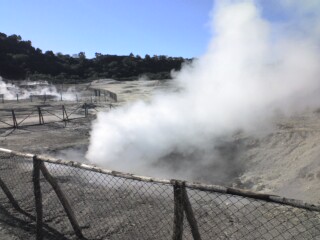
Hot steam at Solfatara
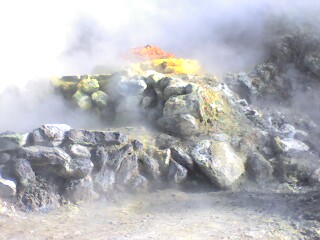
Rocks colored by the minerals from the volcano
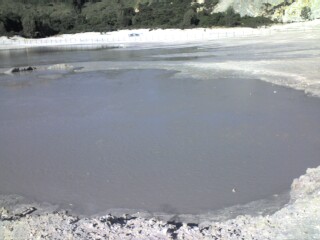
Bubbling mud pool at Solfatara
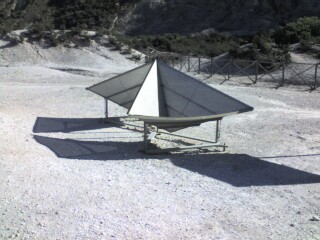
Reflectors that are monitored by satellites to detect any volcanic activity
We have lunch on the waterfront....I have been looking for a local specialty called "panuozzo"-- sandwiches made using pizza as the bread. Driving by, I spot a sign for them so we park and walk back up the street...only to find that the shop is closed. There is a restaurant with a enclosed terrace next door so we decide to eat there. It is a good thing that there is a nice view because we spend a long time waiting for our food. The locals are having the multi-plate seafood antipasto but we just want some pasta. My spaghetti with clams and mussels arrives first and I am just about finished when Diana's pennette with tomato sauce arrives. The house white is very nice--another Falanghina--and the food is fine, but it took an awfully long time for the food to arrive.
After lunch we take a short stroll along the Lungomare Yalta and drive up to the upper town of Pozzuoli to visit the amphitheater--the third largest in Italy. It is now 3:15 pm and it is closed. We read that after November 1, they close at 2:45 pm. So the amphitheater will have to wait for our next visit.
Back to Bacoli and, after a short rest, we take a walk around the center of town, window shopping and trying to co-exist with the cars that share the narrow street with pedestrians. Bacoli's main street is very nice and more extensive than one might think when driving past....there are some very nice shops as well. Our only purchase is some duct tape...to seal up the bottles of olive oil that we will be bringing home.
We have dinner at one of the "downtown" restaurants--Da Caliendo. When we arrive at 8:15, there are only two tables occupied--an American couple and some French tourists. We think that our making reservations was unnecessary but by 9 pm, almost every table is filled. We decide against the seafood antipasto and have the "land based" version--good meats, cheeses and vegetables followed by a very good baked fish with a lemon sauce. We have our second bottle of wine of the day....the house wine which is another Falanghina and is again very delicious. We do notice that every other table is having the extensive seafood antipasto--which starts off with a big plate of white pizza with some kind of condiment, continues with large fried shrimp and seems to go on forever. Next time, we will have seafood antipasto.
For dessert, we have a chocolate cake, which is really some kind of white cake with lots of good chocolate sauce. A very successful dinner.....
Tomorrow we are off to Frascati.
The sun is back but it is comparatively chilly and breezy this morning. Our first stop this morning is the Casina Reale--a hunting lodge--built for Ferdinando IV of Bourbon on one of the volcanic lakes in the area--Lake Fusaro. It was designed by Carlo Vanvitelli, the son of the famous architect Luigi Vanvitelli (actually a German who was quite active in Italy in the 18th century). It sits about 25 yards off shore connected to the land and makes for a pretty picture.

The lake is famous as the first instance of oyster farming (by the Romans) and oysters are still grown there today.

Oyster markers in Lake Fusaro
Next we visit the archaeological site of Cuma--most famous as the location of the Sibyls' cave as described in the Aeneid. H.V. Morton--travel writer par excellence--was completely enchanted with Cuma and we too found it fascinating...but in different ways.
Cuma is in an out of the way corner of the Campi Flegrei; when we get there, there are a lot of staff but we don't see any other visitors. You enter the site up a long grade and through a tunnel hewn out of the rock. There are some burial chambers on the right and the entrance to the Sybils' cave is on your left. The Sibyls of Cumae were in the same business as the oracle at Delphi (and many other prophetesses in the ancient world) and they were sought out by many for their predictive skills. The Books of the Sibyls were prized possessions of the Roman state and they were guarded tightly and consulted frequently by many Roman leaders.
Relevant passages from Virgil are inscribed in marble at the entrance to the tunnel. The tunnel leading to the cave is dug out of the rock facing of the cliff and provides a suitably mysterious entrance hall leading to the cave. The only light comes from openings cut into one side of the tunnel at regular intervals and it is still quite mysterious.

Entrance to Sibyls' Cave

Looking back towards the entrance of the cave of the Sibyls
The petitioners would encounter the Sybils deep in the cave - there's an area where they presumably sat - she would go into a trance and answer their question. For Morton there remained a romantic, "religiously" mysterious air to the place. Not so much for us.
Once out of the cave, we climb the hill to the Acropolis of the town. Cuma was the first Greek settlement in the area -dating to 730 B.C. There are a number of temples to explore and climb around, which also have beautiful views of the surrounding countryside and the islands of Ischia and Procida. The site is very peaceful and we are more or less alone---except for the large number of staff who are reading magazines, strolling the ground and enjoying the beautiful weather. The temple of Apollo and the temple of Jupiter (at the top of the hill) are not in very good shape but on this sunny day with blue skies and no one around, we find them quite attractive and enjoy being in this ancient spot and just poking around both of the ruins.

Temple of Apollo - Cuma

Temple of Apollo - Cuma

View towards Ischia from the Temple of Apollo

The Via Sacra leading to the Temple of Jupiter - Cuma

View of Temple of Jupiter - Cuma

Baptismal Font (from subsequent church) - Temple of Jupiter - Cuma

Temple of Jupiter - Cuma
We spend almost two hours at the site.....while we are admiring the view, we see movement on the beach. There are horses pulling carts moving up and down the beach...we can't tell if they are actually racing or just practicing.

If you look closely on the beach, you can make out the horse and cart.
On the road to our next stop--the Solfatara Volcano--we drive through the Arco Felice. This was a cut in the mountains that was excavated by the Romans and decorated with an elaborate arch which served as the monumental gateway to Cuma. The decorations are now gone but the arch remains intact and traffic flows through it everyday.

Arco Felice
Solfatara, located just above the town of Pozzuoli, is actually a "Campo Flegrea"--a burning field. It is an active volcano that looks like a moonscape punctuated with boiling mud pools and a number of holes in the ground that continuously spew hot steam. It is set in the bottom of a crater and the smell of sulfur is very strong. I had expected that much of the area would look like this but this is the only example that we come across. I am intrigued by the scene as I walk around the crater and feel the hot smelly steam.....one can imagine that this would be thought of as the entrance to the underworld.

View from the top of the crater at Solfatara

Hot steam at Solfatara

Rocks colored by the minerals from the volcano

Bubbling mud pool at Solfatara

Reflectors that are monitored by satellites to detect any volcanic activity
We have lunch on the waterfront....I have been looking for a local specialty called "panuozzo"-- sandwiches made using pizza as the bread. Driving by, I spot a sign for them so we park and walk back up the street...only to find that the shop is closed. There is a restaurant with a enclosed terrace next door so we decide to eat there. It is a good thing that there is a nice view because we spend a long time waiting for our food. The locals are having the multi-plate seafood antipasto but we just want some pasta. My spaghetti with clams and mussels arrives first and I am just about finished when Diana's pennette with tomato sauce arrives. The house white is very nice--another Falanghina--and the food is fine, but it took an awfully long time for the food to arrive.
After lunch we take a short stroll along the Lungomare Yalta and drive up to the upper town of Pozzuoli to visit the amphitheater--the third largest in Italy. It is now 3:15 pm and it is closed. We read that after November 1, they close at 2:45 pm. So the amphitheater will have to wait for our next visit.
Back to Bacoli and, after a short rest, we take a walk around the center of town, window shopping and trying to co-exist with the cars that share the narrow street with pedestrians. Bacoli's main street is very nice and more extensive than one might think when driving past....there are some very nice shops as well. Our only purchase is some duct tape...to seal up the bottles of olive oil that we will be bringing home.
We have dinner at one of the "downtown" restaurants--Da Caliendo. When we arrive at 8:15, there are only two tables occupied--an American couple and some French tourists. We think that our making reservations was unnecessary but by 9 pm, almost every table is filled. We decide against the seafood antipasto and have the "land based" version--good meats, cheeses and vegetables followed by a very good baked fish with a lemon sauce. We have our second bottle of wine of the day....the house wine which is another Falanghina and is again very delicious. We do notice that every other table is having the extensive seafood antipasto--which starts off with a big plate of white pizza with some kind of condiment, continues with large fried shrimp and seems to go on forever. Next time, we will have seafood antipasto.
For dessert, we have a chocolate cake, which is really some kind of white cake with lots of good chocolate sauce. A very successful dinner.....
Tomorrow we are off to Frascati.
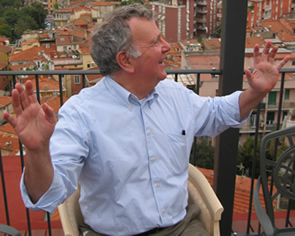

0 Comments:
Post a Comment
<< Home